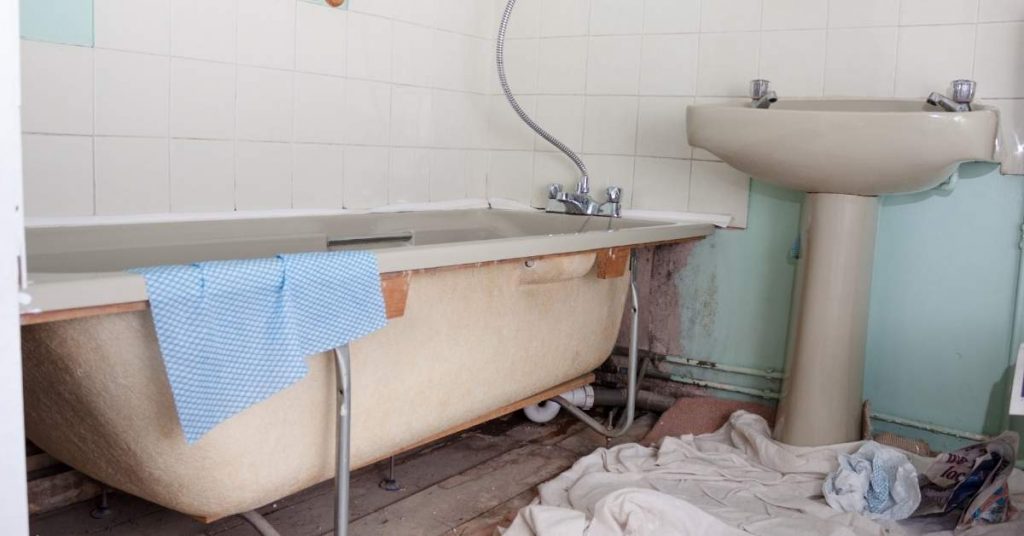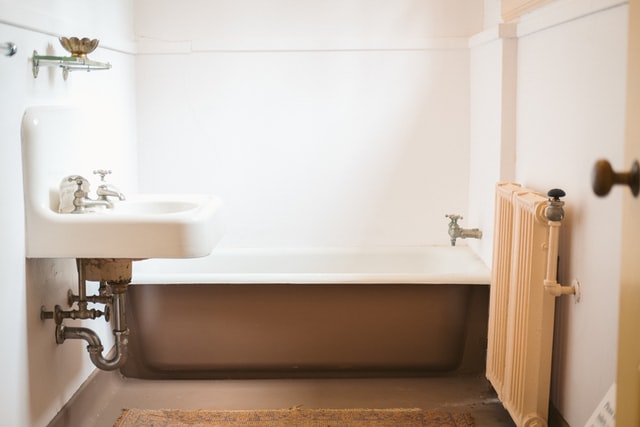There are different types of bathtub materials. Some like fiberglass or acrylic are more prone to cracking, unlike copper or cultured stones tubs that will never crack. But why do bathtubs really crack?

Bathtubs crack due to lack of proper support, application of too much force/weight on the tub, or as a result of the bathtub being made of an easily flexible material.
Abrasive cleaners also causes bathtub finish to peel off, allowing moisture to seep into the tub body and cracks starts to develop.
Most bathtub cracks starts off as small dents or hairline cracks and if not fixed early on can develop into bigger cracks, which might be harder to fix. The good thing is that filling and repairing dents and hairline cracks is a fairly simple task which you don’t need to pay a plumber to do.
There are 2 types of bathtub cracks; hairline cracks and stress cracks. Stress cracks form after a sudden force is applied on the surface on the bathtub, like when you drop a heavy object in the tub. These cracks are not very deep and are relatively easier to fix.
A hairline crack as its name suggests looks like a strand of hair. They usually don’t develop in a day, and are as a result of repeated/constant damage to the tub like banging, use of harsh chemicals among others. Hairline cracks can easily result to bigger cracks.
Depending on the age and extent of damage on your bathtub, you can decide to fix it yourself or hire an expert to refinish it or install a bathtub liner. More on that in this post
In a nutshell, cracking in bathtubs can occur due to various reasons, including heavy impacts, improper installation, or material defects. Solutions may involve repairing minor cracks with epoxy or fiberglass patches for cosmetic improvement, but for significant cracks or structural issues, it’s often necessary to replace the bathtub entirely.
Let us now look into the causes of bathtub cracks in more details.
1. Lack Proper of Support
A bathtub needs to be installed on a flat and strong surface. Installing a bathtub in an uneven surface will cause unequal distribution of weight/force, meaning some parts of the tub will carry more weight than others.
When that happens, the bathtub starts to develop weakness lines along the path receiving the extra weight and cracking is inevitable. In this kind of a situation, the bathtub crack happens at the bottom of the tub and rarely on the side.
If this is the problem, fixing the cracked tub will provide temporary relief. The best and long term solution in this case is to fix the floor itself, otherwise the bathtub is bound to crack again.
2. Too Much Weight on the Bathtub
Each bathtub material has its maximum weight limit. Some materials like fiberglass have a low weight limit compared to materials like cast-iron or copper. Exceeding the maximum weight limit of your tub will definitely cause a crack to develop.
A combination of a badly supported bathtub and too weight applied on the tub are 2 of the most common causes of bathtub cracks. Sitting on the rim of the tub will also cause weakness along the body of the tub after sometime.
Apart from human and water weight, dropping objects in the tub will also weaken it and cause small dents, chipping or scratching. This small holes/dents on the surface of the tub are what contributes to larger cracks after sometime.
3. Flexible Bathtub Material
Some bathtub materials are more solid than others. Bathtubs made of cast-iron, copper, stone resins or even wood will maintain their original shape no matter the conditions they are exposed to. Fiberglass and acrylic bathtubs will flex after some years of usage, with fiberglass being the worst off.
Bathtub cracks therefore affects most people with fiberglass and acrylic bathtubs being the most inexpensive. Fiberglass bathtubs are even more vulnerable since they are porous, meaning they will absorb water.
4. Abrasive Bathtub Cleaners
Abrasive bathtub cleaners like bleach or just about any cleaner with a high concentration of acid will erode the finish on your bathtub surface, subjecting the bathtub body to moisture. This is a rather common problem with fiberglass bathtubs.
As I have already said, these tubs are porous and if not cleaned properly mold/mildew would eventually start to grow. Bathtub owners therefore feel the urge to scrub the tub surface with a strong cleaning agent like bleach.
While these cleaners will definitely get the job done, they lead to more damages. The tub will start to absorb moisture, which will later dry up. The constant intake and evaporation of moisture from the bathtub’s body will weaken it causing cracks.
Cost of Fixing Bathtub Cracks

The cost of fixing a cracked bathtub will greatly depend on whether you will do it on your own or you will be bringing on a professional plumber. A DIY will be cheaper since you will only need to buy the bathtub repair kit.
Unlike bathtub liners or refinishing, fixing a crack on a bathtub involves just the affected area and not the whole bathtub. The problem with this method is that the patch will be clearly visible, but still worth than using thousands on a bathroom remodel.
According to Home Advisor, fixing a cracked bathtub will cost between $20 and $240, depending on the extent of damage, area and whether you will do it on your own or hire a professional. On average the process takes 5 hours including drying time.
Bathtub repair kits costs $20 dollars on average and are readily available online and in home improvement stores. Most of these kits will be good for fiberglass, acrylic and enamel (cast-iron or steel) bathtubs. Make sure you always check though.
One thing to remember is that an expert’s work will look better than if you decide to do it on your own, unless you are a handyman/woman. They will also be in apposition to pinpoint things that are not always obvious to you, some with potential to cost you more money down the line.
How to Fix a Cracked Bathtub
If you decide to fix the cracked bathtub on your own, you need to do it right or otherwise you will not like how your bathtub will look after you are done. These are the steps to follow.
1. Buy the correct kit
While most kits will repair all types of bathtub materials, some are specifically made for some materials. Take you time to know the type of bathtub you have. Most people have a problem telling the difference between fiberglass acrylic bathtubs.
Acrylic bathtubs are thinner but warmer to the touch than fiberglass tubs and also tend to have a smoother finish. Please not that most acrylic bathtubs are reinforced using fiberglass.
Apart from the bathtub material the kit is made for, make sure that you get the correct color finish. You don’t want a patch on your tub which looks very different from the rest of the tub.
2. Clean the Bathtub
Clean the entire bathtub paying special attention to the affected part. Use a strong cleaner to remove grime, soap scum and any type of dirt. You will then need to sand the area around the crack/dent to remove loosely held particles. This will make sure you get a clean and strong bond.
3. Fill the Crack
The epoxy bathtub crack filler will come with precise mixing and application instructions. Take your time to read the instructions to make sure that you have the correct amount and consistency in accordance to the size and extent of your tub crack.
In essence, you only need to mix the 2-part epoxy filler in a tray using a small stick and apply on the crack. Set the tray on a paper towel or cardboard to prevent the filler from spilling where it is not needed.
To have a nice fill, add small amounts of the filler at a time while smoothing around the crack. That is a far better method than having to scoop excess filler. Once you have nicely filled the crack give it time to dry.
4. Sand and Paint the Tub
Once the filler has dried, sand it with a fine sand paper until it feels as smooth as the rest of the bathtub. To remove the fine particles left behind, dip a piece of cotton in an alcohol bottle and wipe the sanded part. Give it some time to dry.
Use a small brush to paint the tub area you just fixed. Wait for the first coat to dry before adding more coats as desired. Buff the tub if needs be for a smooth finish.

How to Prevent Bathtub Cracks
Preventing bathtub cracks means doing the opposite of what causes them to crack in the first place. Some of these things are actually things we can do while some like when you accidentally drop a wine bottle in the tub are out of our control.
The first thing to do is to ensure that when you are installing a new bathtub it is done correctly. The tub needs to be set on a level and smooth surface to support its weight uniformly. When installed correctly, all tubs will support the weight of any bather.
Another thing to do is to avoid abrasive cleaners while cleaning the tub. If you need something strong but gentle to clean your bathtub with, use a mixture of vinegar and baking soda. These 2 are fantastic cleaning agents and are safe to use on your bathtub and also for people on a septic system.
If you have a fiberglass bathtub, avoid sitting or placing heavy loads on the rim of the bathtub. This causes it to warp/flex over time, and cause hairline cracks or even leads to peeling off of the tub finish.
For people with small kids, try to make sure that they don’t go to the bathroom with their toys. The reason some bathtubs cracks is because kids are constantly banging their toys against them.





